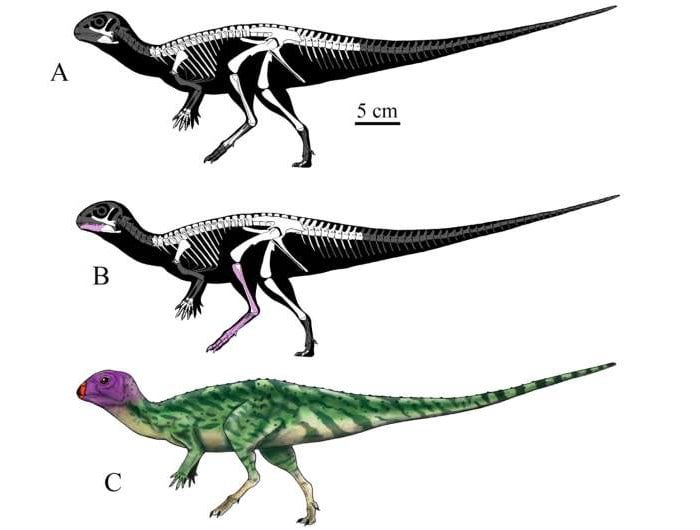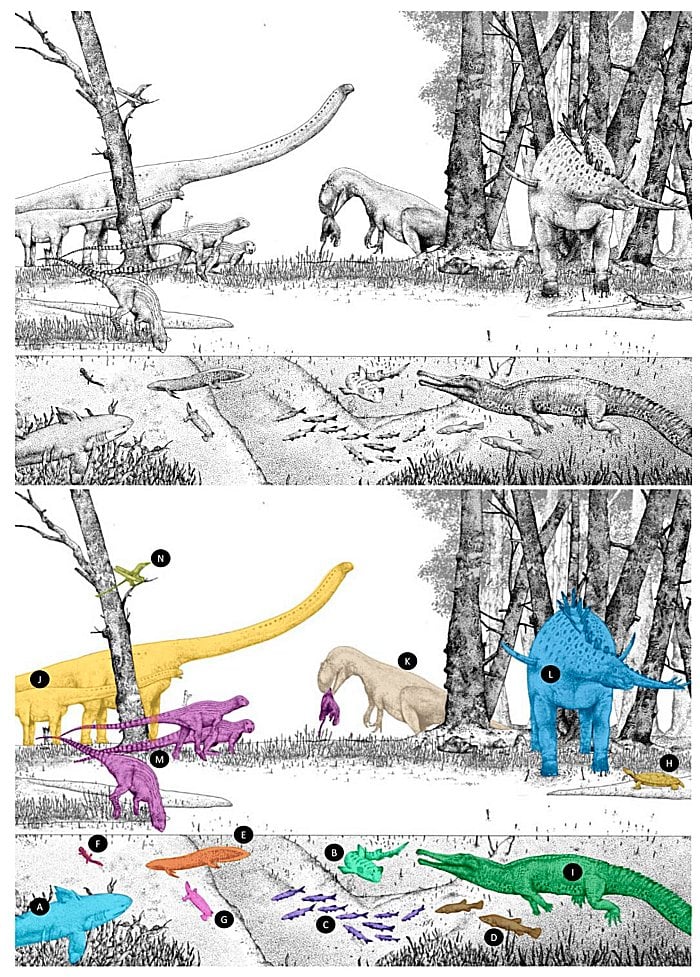Conny Waters – AncientPages.com – A new species of dinosaur was discovered in Northeastern Thailand, in 2012, and now, a team of multidisciplinary experts in paleontology led by Sita Manitkoon of the Palaeontological Research and Education Center of Mahasarakham University, Thailand, presents their research that have focused on this previously unknown species, later named Minimocursor phunoiensis.

Reconstruction of Minimocursor phunoiensis gen. et sp. nov. (PRC 150) in left lateral view (except reversed images of the right jugal). Recovered elements of the holotype shown in white (A); holotype with referred materials, which are not to scale, shown in light purple (B); and life restoration (C). Drawings by Wongwech Chowchuvech (A,B) and Sita Manitkoon (B).
The researchers describe the dinosaur as approximately 2 meters, and the one feeding on plants (herbivore).
“There are more than 5,000 fossil samples collected from about 1,200 m 2 excavated area. It is also famous for its diversity since at least three groups of dinosaurs including Mamenchisauridae, Sinraptoridae, and small Ornithopoda were also discovered there…” as described in the paper.

Palaeoenvironmental interpretation of the Late Jurᴀssic Phu Kradung Formation of northeastern Thailand, including hybodont indet. with egg capsules (A), Acrodus kalasinensis (B), ptycholepid indet. (C), Isanichthys lertboosi (D), Ferganoceratodus annekempae (E), brachyopid indet. (F), Phunoichelys thirakupti (G), Kalasinemys prasarttongosothi (H), Indosinosuchus potamosiamensis (I), mamenchisaurid indet. (J), metriacanthosaurid indet. (K), stegosaur indet. (L), Minimocursor phunoiensis (M), and rhamphorhynchoid indet. (N). Drawing by Sakka Weerataweemat.
The place of the discovery of the fossil is Thailand’s geological area, known as the Phu Kradung Formation at the Phu Noi, located in Khammuang District, Kalasin Province, and widely known as the largest dinosaur excavation site in Thailand.
The Phu Noi region contains a wealth of specimens, and particularly, this dinosaur fossil represents one of the best-preserved dinosaurs ever found in Southeast Asia. This is the “earliest record of neornithischians in Southeast Asia, and the first dinosaur taxon named from the Phu Kradung Formation of Thailand.”
Further the team states that the dinosaur Minimocursor phunoiensis was an immature individual when it died. Numerous isolated limb bones of different sizes, and attributed to basal neornithischians were also found, which indicates that these dinosaurs were abundant in the Phu Noi site.
The body length of this dinosaur is estimated to have been about 0.6 m, comparable with Agilisaurus. We ᴀssume that it may have been up to two meters long at an adult stage, based on the longest femur found (about 26.6 cm in length).
The dinosaur Minimocursor phunoiensis represents the oldest record of a neornithischian dinosaur in Southeast Asia so far.
Numerous ornithischian remains formed of postcranial elements of various sizes have been found at Phu Noi and can be referred to this taxon, indicating that this dinosaur was abundant in this area.
It lived together with mamenchisaurid sauropods, metriacanthosaurid theropods, and other vertebrates from the rich vertebrate ᴀssemblages of the lower part of the Phu Kradung Formation. It has been dated by researchers to about 145 million-year-old .
Paper – A New Basal Neornithischian Dinosaur from the Phu Kradung Formation (Upper Jurᴀssic) of Northeastern Thailand
Written by Conny Waters – AncientPages.com Staff Writer





